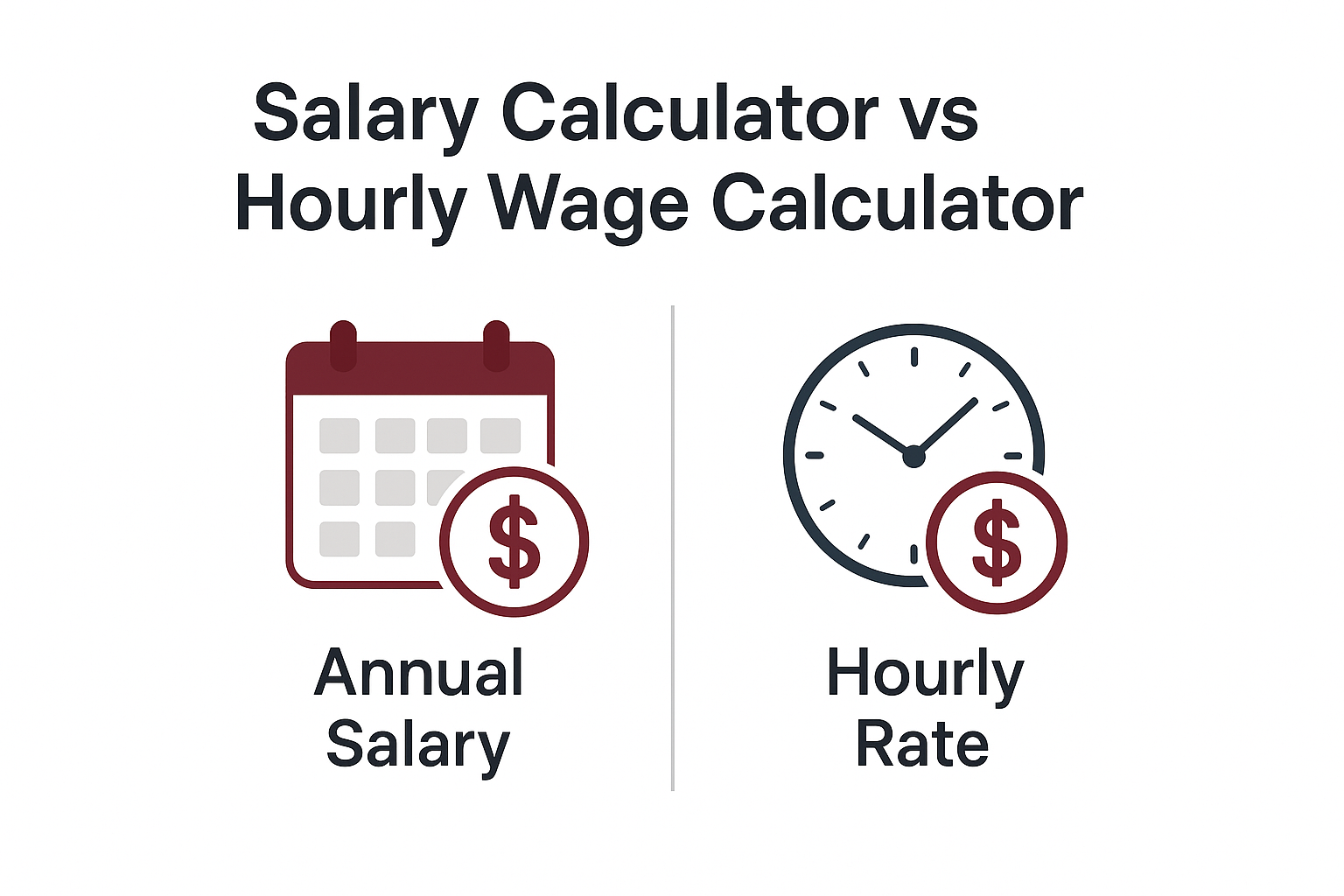Salary Calculator
Embed this calculator
Adjust the size if needed, then copy the code below into your page or blog. The calculator will load in an iframe and stay updated automatically.
✅ Works on most website builders (WordPress, Elementor, HTML, etc.) · Please keep the credit link to support future free tools.
🔹 Table of Contents
- Salary Calculator
- What is a Salary Calculator?
- How Does a Salary Calculator Work?
- Why Use a Salary Calculator?
- Worked Salary Examples
- Factors That Affect Your Salary
- Gross vs Net Salary Explained
- Real-Life Applications of Salary Calculations
- Salary Calculator vs Hourly Wage Calculator
- Salary Calculator Limitations
- Tips for Using the Salary Calculator Effectively
- Frequently Asked Questions
- References & Sources
🔹 What is a Salary Calculator?
A salary calculator is a tool that helps employees and employers convert an annual salary into monthly, weekly, daily, and hourly wages. It simplifies the process of understanding how much you actually earn per pay period and how deductions such as taxes, pension contributions, or insurance affect your take-home pay.
By entering your gross annual salary, estimated tax/deduction percentage, and your working hours, the calculator provides both gross and net breakdowns across different time frames. This makes it easier to budget, compare job offers, or negotiate a raise.
The salary calculator is especially useful for freelancers, contractors, and anyone who works flexible hours, as it allows them to estimate pay more accurately. Whether you’re looking at your loan obligations or planning for retirement savings, knowing your real earnings is the first step.
🔹 How Does a Salary Calculator Work?
The salary calculator takes your annual salary and divides it into smaller pay periods (monthly, weekly, daily, hourly). It also applies tax and deductions to show the difference between gross salary and net salary.
- Monthly Salary: Annual Salary ÷ 12
- Weekly Salary: Annual Salary ÷ Weeks per Year (default 52)
- Daily Salary: Weekly Salary ÷ Workdays per Week (default 5)
- Hourly Salary: Weekly Salary ÷ Hours per Week (default 40)
For net salary, the formula is:
Net Salary = Gross Salary × (1 − Tax Rate ÷ 100)
Example: If your annual salary is €50,000 and deductions are 20%, then your net annual salary is €40,000, which equals about €3,333 per month.
This breakdown gives you a clear view of both your pre-tax and after-tax earnings, making it easier to plan expenses and savings.
🔹 Why Use a Salary Calculator?
A salary calculator is more than just a conversion tool — it’s a practical way to understand your earning power and how it fits into your financial goals. Whether you’re an employee, freelancer, or job seeker, this tool provides clarity that goes beyond a simple paycheck.
- Budget Planning: Break down your income into weekly or daily earnings for better expense management.
- Job Comparisons: Compare offers from different employers in a consistent format.
- Negotiations: Know your worth when discussing salary increases or freelance rates.
- Financial Goals: Understand your true net income to plan for savings, loans, or investments.

For example, if you’re considering a mortgage, knowing your net monthly salary helps determine how much you can realistically afford.
🔹 Worked Salary Examples
To better understand how the salary calculator works, here are some practical examples showing both gross and net pay across different salaries and tax rates.
| Annual Salary | Tax Rate | Net Annual | Net Monthly | Net Hourly |
|---|---|---|---|---|
| $40,000 | 15% | $34,000 | $2,833 | $16.35 |
| €60,000 | 20% | €48,000 | €4,000 | €23.08 |
| £100,000 | 25% | £75,000 | £6,250 | £36.06 |
For instance, if you earn $40,000 annually with a 15% deduction, your net monthly pay comes to $2,833 and your net hourly rate is about $16.35 (based on 40 hours/week, 52 weeks/year).
These breakdowns help in planning for savings growth or comparing the impact of working fewer or more hours per week.
🔹 Factors That Affect Your Salary
While a salary calculator provides quick estimates, your actual pay depends on several important factors. Understanding these helps explain why two people with similar roles might earn very different amounts.
- Experience & Skills: More years in the field and specialized expertise usually increase earning potential.
- Education: Advanced degrees or certifications can significantly raise salary offers.
- Industry: Salaries vary widely between sectors like finance, tech, healthcare, or education.
- Location: Wages differ by country and even city — for example, salaries in London or New York are generally higher than in smaller towns.
- Company Size: Larger corporations often offer higher pay packages compared to startups or small businesses.
These factors, combined with tax rates and deductions, determine your true take-home pay. That’s why using the salary calculator alongside tools like the currency converter is useful when considering international job opportunities.
🔹 Gross vs Net Salary Explained
When discussing pay, it’s important to distinguish between gross salary and net salary.
Gross Salary is the total amount an employer agrees to pay you before any deductions. This includes base pay, bonuses, and allowances.
Net Salary (often called take-home pay) is the amount you actually receive after taxes, pension contributions, insurance, and other deductions are applied.
The difference can be significant — for example, a gross annual salary of €60,000 with a 20% deduction results in a net salary of €48,000.
Understanding this difference helps you budget more realistically and compare job offers more effectively.
🔹 Real-Life Applications of Salary Calculations
A salary calculator isn’t just theoretical — it has many real-world uses that make financial decisions easier and more accurate.
- Budgeting: Plan rent, groceries, and bills based on your actual monthly take-home pay.
- Job Hunting: Compare multiple offers and see the net difference between positions.
- Relocation: Check how salaries change when moving to a new city or country, and combine results with a currency calculator.
- Savings Goals: Estimate how much you can set aside monthly toward investments, loans, or retirement.
For example, if you plan to move abroad, using both a salary calculator and a currency converter can help you determine whether your new income will cover your expenses while maintaining the same lifestyle.
🔹 Salary Calculator vs Hourly Wage Calculator
Both salary and hourly wage calculators help you understand your earnings, but they serve slightly different purposes. Knowing when to use each tool can make your financial planning more accurate.

| Aspect | Salary Calculator | Hourly Wage Calculator |
|---|---|---|
| Main Purpose | Converts annual salary into monthly, weekly, daily, and hourly pay. | Converts hourly rate into weekly, monthly, and annual income. |
| Best For | Employees with fixed annual contracts. | Freelancers, contractors, or part-time workers. |
| Tax/Deductions | Applies tax percentage to show net vs gross salary. | Shows estimated earnings based on hours worked. |
For example, if you’re paid an annual salary, the salary calculator helps you understand your monthly or hourly breakdown. On the other hand, if you work on an hourly basis, an Hourly Wage Calculator will help you estimate your yearly income based on hours worked.
🔹 Salary Calculator Limitations
While a salary calculator is a useful tool for quick estimates, it has certain limitations that should be kept in mind when planning finances.
- Estimated Taxes: The calculator applies a flat tax or deduction percentage, which may not reflect real progressive tax brackets.
- Excludes Benefits: Health insurance, retirement contributions, bonuses, and stock options are not included.
- Work Variations: Overtime, unpaid leave, or variable work hours can change real take-home pay.
- Regional Rules: Tax deductions differ by country and state, so results may vary significantly depending on location.
- Currency Fluctuations: If converting salaries internationally, exchange rates can impact accuracy.
For more precise planning, combine the salary calculator with professional tax advice and financial planning tools such as the Retirement Calculator.
🔹 Tips for Using the Salary Calculator Effectively
To get the most out of the salary calculator, use it strategically when planning your finances and career decisions.
- Be Accurate: Enter your actual annual salary, hours per week, and deductions to get realistic results.
- Test Scenarios: Adjust tax rates or work hours to see how your income changes under different conditions.
- Compare Offers: Use the calculator to compare multiple job offers in terms of real take-home pay.
- Think Long-Term: Pair salary insights with tools like the Compound Interest Calculator to project savings growth.
- Update Regularly: Recalculate whenever your salary, tax rate, or work schedule changes.
By using the calculator thoughtfully, you gain a clearer picture of your current financial situation and can plan effectively for future goals.
🔹 Frequently Asked Questions
🔹 References & Sources
| Source | Description |
|---|---|
| Calculator.net – Salary Calculator | Reference competitor calculator for structure and breakdown features. |
| Investopedia – Salary Definition | Explains what salary is, how it’s structured, and key differences from hourly pay. |
| Wikipedia – Salary | General background and global context for salaries, benefits, and deductions. |
| IRS – U.S. Tax Information | Official resource for tax brackets and deductions in the United States. |
| European Commission – Taxation for Individuals | Official EU reference for understanding income taxes and deductions across Europe. |
